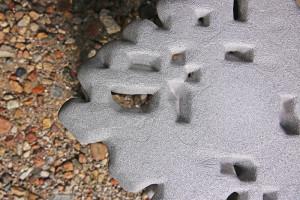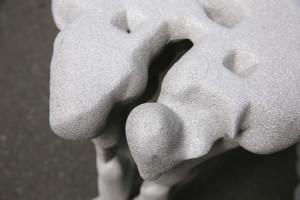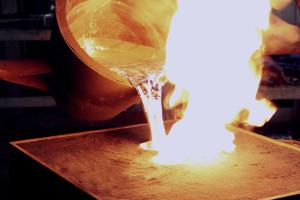 This strange looking solid aluminum stool was designed and made by NOWlab--the same studio that brought us the ‘Glacier’ table–using a combination of traditional fabrication methods, digital generative form-finding software and large-format 3D printing technology. The T 1000 stool is part of NOWlab founding partners Jörg Petri and Daniel Büning’s ongoing research into the development of new manufacturing processes using cutting edge computational design methods. Obviously the stool is named after the shapeshifting robot from Terminator 2 and was inspired by its ability to quickly liquefy and assume virtually any form that it desired.
This strange looking solid aluminum stool was designed and made by NOWlab--the same studio that brought us the ‘Glacier’ table–using a combination of traditional fabrication methods, digital generative form-finding software and large-format 3D printing technology. The T 1000 stool is part of NOWlab founding partners Jörg Petri and Daniel Büning’s ongoing research into the development of new manufacturing processes using cutting edge computational design methods. Obviously the stool is named after the shapeshifting robot from Terminator 2 and was inspired by its ability to quickly liquefy and assume virtually any form that it desired.
The T 1000 is the result of complex biomorphic forms being made with a generative computational form-finding process that employs a computer algorithm to automatically produce an optimized structural shape. The algorithm distributes material within the virtual design space based on a set of pre-programmed conditions that outline the type of load the object is required to support. The resulting shape of the object is the most structurally sound form that is required under those conditions and produces maximum rigidity while using the minimal amount of material to do so.
The final stool looks like an organic shape because the algorithm will allocate material only to the areas that are structurally required, similarly to natural formations like trees. So not only are objects made with this process visually analogous to shapes made by nature, but they also share the same material to stiffness ratio. While digital generative form-finding software is not a new development, the complex geometries that it produced have always been virtually impossible to manufacture. Traditional manufacturing methods would require a CNC mill that would be incapable of recreating any undercuts, odd or organic shapes.
NOWlab has been researching methods of applying this type of auto-generative software to generate 3D printable objects that have no issues with producing the required complex shapes and forms. Not only are they exploring the use of 3D printing as a replacement for direct manufacturing, but also using it as a tool to augment more common manufacturing methods. In this case NOWlab 3D printed a mold of the T 1000 stool and then used traditional foundry methods to cast the solid aluminum stool.
“The T 1000 directly benefits from the newly established digital process chain consisting of algorithmic structural form-finding, 3D printing and traditional craftsmanship. For our vision and main focus is to alter the way how things are made in a contemporary manner, without negating previous methodologies of craftsmanship or industrial manufacturing. The T1000 project therefore was an intensive investigation on digital algorithmic design procedures in combination with large-format 3D printing technology to generate a previously unseen digitally informed furniture piece,” NOWlab explains on their website.
The mold was 3D printed on a voxeljet VX4000 3D printer, one of the industry’s largest industrial 3D printers that boasts a 157.5 x 79 x 39 inch (4000 x 2000 x 1000 mm) build envelope. The mold was 3D printed with a fine silica-based sand material, and once the excess material was removed the mold was ready to be filled. NOWlab worked with a local metal foundry named Blöcher to cast T1000 as a piece of solid aluminum. Once the aluminum stool was removed from the cast, Petri and Büning wanted a natural finish so there was very little post processing required. They left the sand-like texture intact, however it would be possible to machine the surface of the stool until it was completely smooth.
Because it was cast in solid metal, there was no protective coating necessary and the stool was ready to be used either indoor or out. This new process was used in a crude, organic way, but it is possible to merge foundry technology with a generative form-finding design process to build virtually anything that requires the minimum amount of material required to produce the strongest object. There are obvious applications in furniture design, but there would also be plenty of ways to use it for construction projects, and even car design. Discuss this process in the 3D Printed Aluminum Stool forum thread on 3DPB.com.
Subscribe to Our Email Newsletter
Stay up-to-date on all the latest news from the 3D printing industry and receive information and offers from third party vendors.
You May Also Like
Changing the Landscape: 1Print Co-Founder Adam Friedman on His Unique Approach to 3D Printed Construction
Additive construction (AC) is much more versatile than it seems, at first: as natural as it is to focus on the exciting prospect of automated home construction, there’s far more...
US Army Corps of Engineers’ Megan Kreiger on the State of Construction 3D Printing
Despite last year’s gloomy reports about the financial state of the additive manufacturing (AM) industry, there’s no doubt that we’re actually witnessing the birth of a sector rather than its...
3D Printing Webinar and Event Roundup: April 21, 2024
It’s another busy week of webinars and events, starting with Hannover Messe in Germany and continuing with Metalcasting Congress, Chinaplas, TechBlick’s Innovation Festival, and more. Stratasys continues its advanced training...
Profiling a Construction 3D Printing Pioneer: US Army Corps of Engineers’ Megan Kreiger
The world of construction 3D printing is still so new that the true experts can probably be counted on two hands. Among them is Megan Kreiger, Portfolio Manager of Additive...

































